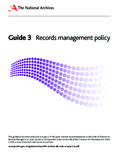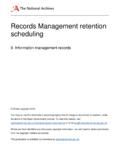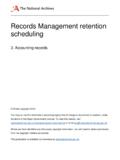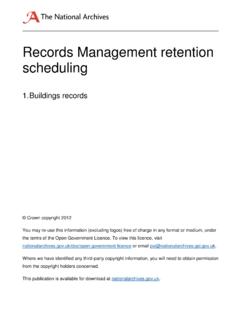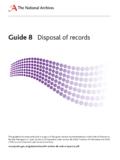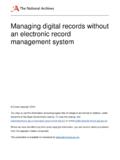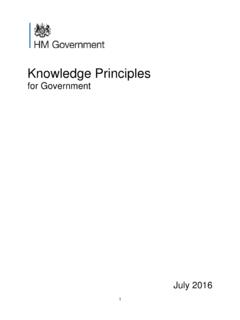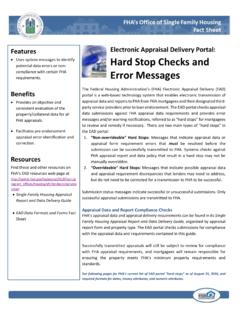Transcription of What is appraisal - The National Archives home page
1 what is appraisal ? Crown copyright 2013 You may re-use this information (excluding logos) free of charge in any format or medium, under the terms of the Open Government Licence. To view this licence, visit or email Where we have identified any third-party copyright information, you will need to obtain permission from the copyright holders concerned. This publication is available for download at what is appraisal ? Last updated August 2013 Page 2 of 7 Contents Scope .. 3 what is appraisal ? .. 3 Benefits of appraising records .. 4 Principles of effective appraisal .. 5 The role of The National Archives .. 6 Key documents .. 7 Further 7 what is appraisal ? Last updated August 2013 Page 3 of 7 Scope This guidance applies to public records as defined by the Public Records Act 19581, and all organisations responsible for such records.
2 This covers all administrative and departmental records belonging to Her Majesty, held in any format, including paper, digital, audio, film or model format. Under section 3 of the Act, it is the duty of every person responsible for public records to make arrangements for the selection of those records which ought to be permanently preserved and for their safe-keeping. Therefore it is the responsibility of government departments and agencies to judge the value of their records for both ongoing business activities and historical preservation. This includes developing specific selection criteria by which to make these appraisal decisions. The Keeper of Public Records, CEO of The National Archives , is responsible for co-ordinating and supervising all action taken to select public records for permanent preservation.
3 This includes the development and issuing of guidance on how to approach the appraisal of departmental records. what is appraisal ? appraisal is the process of distinguishing records of continuing value from those of no further value so that the latter may be eliminated. Records can possess different types or degrees of value to an organisation, which will affect how long collections need to be kept. In general, there are two layers of value: Primary value: the value to the organisation that created them for administrative, legal and fiscal purposes. Identifying records of ongoing business value will: assist efficient and effective administration; enable decision making and policy development based on current information; and allow organisations to be accountable in terms of the management of resources, as well as legal and financial scrutiny 1 what is appraisal ?
4 Last updated August 2013 Page 4 of 7 Secondary value: the additional historical value to the organisation and wider society. This can include evidential value derived from the way the record documented the history, structure and functions of an organisation, and informational value in providing research material on persons, places and subjects. Select records for permanent preservation which show the significance of the functions and activities of departments, and which provide information relevant to themes outlined in The National Archives Records collection policy. These records tend to include high level policy or complex case files Benefits of appraising records Developing a framework for routinely determining the value of record collections will bring a number of benefits.
5 These include: supporting departments in meeting their statutory responsibilities, including under the Public Records Act 1958 and Freedom of Information Act 20002 maintaining the efficiency of departmental records management systems by limiting their contents to only those records which are of continuing value for business and archival purposes, and enabling the controlled destruction of those which are not ensuring that pertinent material is retained for as long as it is necessary to enable informed policy development allowing departments to be accountable for the management of resources and policy-making to the public enabling efficient and effective organisational changes that may arise at short notice as a result of Machinery of Government developments 2 what is appraisal ?
6 Last updated August 2013 Page 5 of 7 Principles of effective appraisal In order to create a framework for making judgements on the value of records in an efficient manner, organisations should consider these principles: Timing: Departments should aim to appraise record value as part of routine records management activities as early as possible. This will ensure that records are kept as long as necessary to meet business needs. Timing should also take into account the statutory deadlines (the 20 year rule) by which records of historical value need to be transferred to The National Archives or Place of Deposit. The traditional Grigg system of appraisal in which records are appraised in a two stage process (at five years for ongoing business value, and 25 years for archival value) is no longer practical for assessing digital records or other formats which appear in large volumes.
7 Methodology: In order to make appraisal more efficient, departments should look to judge the value of their record holdings at an appropriate level. This means, where possible, making decisions on groups of records or categories of information based on the context in which those records were created or are currently used. Understanding key departmental objectives, functions, and business processes will help identify core information assets, and support decisions around retention periods. It should also reduce the need to review records on an individual basis, which can be time-consuming. Different methods of appraisal are described in the National Archives Best practice guide. Engagement: Determining the value of records should involve input from those areas of the business which were involved in their creation and management.
8 This will satisfy specific usability and legislative requirements to keep certain records. The operational process of embedding appraisal also needs involvement from other stakeholders. For example, understanding the structure of digital records and applying different periods of retention across the system that holds them will require input from colleagues involved in IT, information assurance and senior management. Documentation: Once the value of record holdings has been determined, document these decisions and keep this information up to date. Creating Information Asset Registers will help monitor specific information risk, as well as support the management what is appraisal ? Last updated August 2013 Page 6 of 7 of records according to their value. The National Archives has developed guidance on what to keep to help departments create schedules for important record collections.
9 By creating and maintaining this type of documentation, departments will find it easier to take responsible decisions on the disposal of records which are no longer required for business use. Guidance: The National Archives has produced a Records collection policy to help identify records of potential historical value. This guidance outlines the criteria by which records should be judged to determine their long term historical value. When appraising records, it is important to understand these generic selection criteria and apply them to the specific context of the organisation responsible for creating the records. Departments are responsible for developing specific criteria for judging whether records fall under The National Archives collection themes. Tools are available to help with this, including The National Archives appraisal report template.
10 The role of The National Archives As part of its statutory obligations to help departments meet their responsibility to appraise records and select those of historical value, The National Archives will: provide training on the principles of appraisal , and how it applies to the context of Government departments define generic criteria which will assist departments in identifying records of the highest historical value recommend appropriate appraisal methods in light of changes to the format and context of record collections advise departments on creating Operational selection policies, appraisal reports, and other supporting guidance on appraisal , which are published on The National Archives website provide quality assurance on departmental selection decisions which identify records of historical value before they are transferred to The National Archives or Place of Deposit what is appraisal ?

